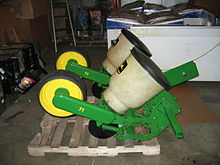
Sowing is the process of planting seeds. An area or object that has had seeds planted in it will be described as a sowed or sown area.

Jethro Tull was an English agriculturist from Berkshire who helped to bring about the British Agricultural Revolution of the 18th century. He perfected a horse-drawn seed drill in 1701 that economically sowed the seeds in neat rows, and later developed a horse-drawn hoe. Tull's methods were adopted by many landowners and helped to provide the basis for modern agriculture.
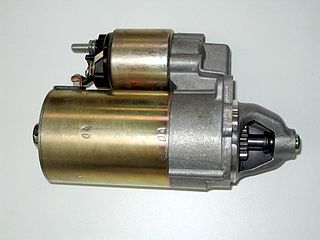
A starter is a device used to rotate (crank) an internal-combustion engine so as to initiate the engine's operation under its own power. Starters can be electric, pneumatic, or hydraulic. The starter can also be another internal-combustion engine in the case, for instance, of very large engines, or diesel engines in agricultural or excavation applications.

A tractor is an engineering vehicle specifically designed to deliver a high tractive effort at slow speeds, for the purposes of hauling a trailer or machinery such as that used in agriculture, mining or construction. Most commonly, the term is used to describe a farm vehicle that provides the power and traction to mechanize agricultural tasks, especially tillage, and now many more. Agricultural implements may be towed behind or mounted on the tractor, and the tractor may also provide a source of power if the implement is mechanised.

Mechanization is the process of changing from working largely or exclusively by hand or with animals to doing that work with machinery. In an early engineering text a machine is defined as follows:
Every machine is constructed for the purpose of performing certain mechanical operations, each of which supposes the existence of two other things besides the machine in question, namely, a moving power, and an object subject to the operation, which may be termed the work to be done. Machines, in fact, are interposed between the power and the work, for the purpose of adapting the one to the other.
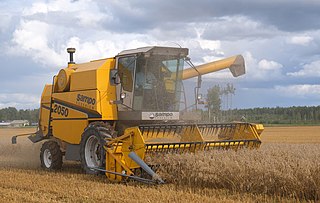
The modern combine harvester, or simply combine, is a machine designed to harvest a variety of grain crops. The name derives from its combining four separate harvesting operations—reaping, threshing, gathering, and winnowing—to a single process. Among the crops harvested with a combine are wheat, rice, oats, rye, barley, corn (maize), sorghum, millet, soybeans, flax (linseed), sunflowers and rapeseed. The separated straw, left lying on the field, comprises the stems and any remaining leaves of the crop with limited nutrients left in it: the straw is then either chopped, spread on the field and ploughed back in or baled for bedding and limited-feed for livestock.

Deere & Company, doing business as John Deere, is an American corporation that manufactures agricultural machinery, heavy equipment, forestry machinery, diesel engines, drivetrains used in heavy equipment, and lawn care equipment. It also provides financial services and other related activities.

Fluid power is the use of fluids under pressure to generate, control, and transmit power. Fluid power is conventionally subdivided into hydraulics and pneumatics. Although steam is also a fluid, steam power is usually classified separately from fluid power. Compressed-air and water-pressure systems were once used to transmit power from a central source to industrial users over extended geographic areas; fluid power systems today are usually within a single building or mobile machine.
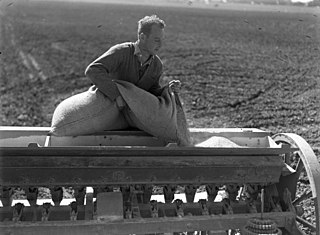
A seed drill is a device used in agriculture that sows seeds for crops by positioning them in the soil and burying them to a specific depth while being dragged by a tractor. This ensures that seeds will be distributed evenly.

A broadcast seeder, alternately called a broadcaster, broadcast spreader or centrifugal fertilizer spreader (Europe) or "spinner" (UK), is a farm implement commonly used for spreading seed where no row planting is required, lime, fertilizer, sand, ice melt, etc., and is an alternative to drop spreaders/seeders. Apart from spinners there is also a type of broadcast spreader called "wagtail spreader", used with tractors.
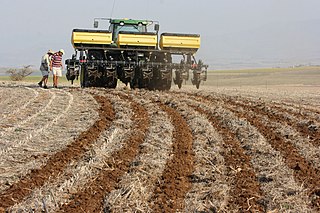
Strip-till is a conservation system that uses a minimum tillage. It combines the soil drying and warming benefits of conventional tillage with the soil-protecting advantages of no-till by disturbing only the portion of the soil that is to contain the seed row. This type of tillage is performed with special equipment and can require the farmer to make multiple trips, depending on the strip-till implement used, and field conditions. Each row that has been strip-tilled is usually about eight to ten inches wide.
Kinze Manufacturing, Inc. is an American company that produces agricultural equipment.
Roths Industries, Inc. (1945–1960) was a manufacturer of small garden tractors and other agricultural equipment founded by Herbert C. Roths in Alma, Michigan. The company manufactured Garden King Walking Tractors, BesRo Riding Tractors, and Till Ro Stalk Cutters.

Agricultural machinery relates to the mechanical structures and devices used in farming or other agriculture. There are many types of such equipment, from hand tools and power tools to tractors and the countless kinds of farm implements that they tow or operate. Diverse arrays of equipment are used in both organic and nonorganic farming. Especially since the advent of mechanised agriculture, agricultural machinery is an indispensable part of how the world is fed. Agricultural machinery can be regarded as part of wider agricultural automation technologies, which includes the more advanced digital equipment and robotics. While agricultural robots have the potential to automate the three key steps involved in any agricultural operation, conventional motorized machinery is used principally to automate only the performing step where diagnosis and decision-making are conducted by humans based on observations and experience.
The John Deere DB120 is an agricultural planter made by Bauer Built Mfg. in Paton, Iowa. Upon its release in 2009, it was the largest production planter in the world. It has a 120 feet (37 m) wide tool-bar and plants 48 rows which are 30 inches (760 mm) apart. It is estimated that the planter should sow 90 to 100 acres (0.40 km2) per hour at 5 to 5.5 miles per hour ground speed. This means that in a 12-hour day it will plant almost two sections of land. John Deere claims that the planter is 30% more productive than their 36 row DB90 planter. To transport such an incredibly wide implement, the DB120 folds into five sections. The planter weighs in at over 20 tons empty and almost 24 tons when loaded with seed. The DB120 had a limited release in 2009 with orders being taken for the 2010 season. It retailed at (US)$345,000 dollars. In 2020, the base price on the John Deere website was over $500,000.

A driverless tractor is an autonomous farm vehicle that delivers a high tractive effort at slow speeds for the purposes of tillage and other agricultural tasks. It is considered driverless because it operates without the presence of a human inside the tractor itself. Like other unmanned ground vehicles, they are programmed to independently observe their position, decide speed, and avoid obstacles such as people, animals, or objects in the field while performing their task. The various driverless tractors are split into full autonomous technology and supervised autonomy. The idea of the driverless tractor appears as early as 1940, but the concept has significantly evolved in the last few years. The tractors use GPS and other wireless technologies to farm land without requiring a driver. They operate simply with the aid of a supervisor monitoring the progress at a control station or with a manned tractor in lead.

A Happy Seeder is a no-till planter, towed behind a tractor, that sows (plants) seeds in rows directly without any prior seedbed preparation. It is operated with the PTO of the tractor and is connected to it with three-point linkage. It consists of a straw managing chopper and a zero till drill that makes it possible to sow new crop in the residue of the previous crop. Flail type straight blades are mounted on the straw management rotor that chops the stubbles that comes in contact with the sowing tine. It deposits the residue of the previous crop over the sown field as mulch. Mainly, it is used to sow wheat after the paddy harvest in North India.

The Farmall F-12 is a small two-plow row crop tractor produced by International Harvester under the Farmall brand from 1932 to 1938, with approximately 123,000 produced. An improved model, the two-plow F-14, was produced beginning in 1938 and ending in 1939, when the Farmall letter series tractors were introduced.
A super seeder is a no-till planter, towed behind a tractor, that sows (plants) especially wheat seeds in rows directly without any prior seedbed preparation. It is operated with the PTO of the tractor and is connected to it with three-point linkage. The Super Seeder is an advanced agricultural machine than Happy seeder, engineered to revolutionize traditional farming methods. It offers an efficient, time-saving solution, allowing farmers to sow wheat seeds directly after rice harvest without the need for prior stubble burning, thereby contributing significantly to environmental preservation. It is mostly used to sow wheat seeds after the paddy harvest in North Indian states.
